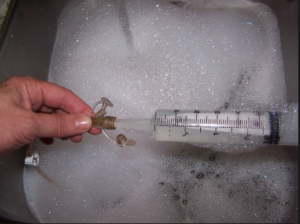
“Necessity is the mother of invention”. Truer words have never been spoken when it comes to living with a feeding tube. From the beloved squirrel syringes to modifying feeding pump bags, the feeding tube community often has the best tips and tricks to make the process easier. The one thing we can’t seem to agree on is the hands-down best way to clean the feeding tube extension sets!

A tried & true method of cleaning a feeding tube extension.
We’ve reached out to the tubie community to find the best way to clean the feeding tube extension sets. Although there’s no one winner, some of the responses were downright ingenious. Instead of trying to summarize, here’s some of our favorite responses:
“I clean the bolus port part very gently with a flexible dental pick if needed.” –Lisa G.
Tanya H. got creative by sharing this, “I do the same beginning process that I do with my milking machine lines for milking goats…… first run very cold water thru tube lines first. Hot water will cook the milk/formula/feed onto the tube. Then I run hot soapy water thru. Then every day I soak in a solution of vinegar & water to disinfect. Use new extension every week.”
Jodi M. shares that “White vinegar works great followed by hot water flush.”
A more detailed way of cleaning with hot water and dish soap comes from Heather G. She says to “Soak in hot water, dish soap (Palmolive) and 2-4 denture tables (efferdent) for 30min. Rinse with hot water and air dry.”
Brittany H shares that “I roll the tube between my fingers to get the crud out…. and use a bottle brush (the end made for the bottle nipple) to clean out the top of the extension.”
”I was told don’t use anything you wouldn’t eat…and hot water with a mixture of 1/4 cup to 1tbsp baking soda. Works like a charm.” –Les R.
Eugena M. shares “I use dawn soup with a cap full of bleach soak a few hours and air dry.”
”I use an endoscopy brush and hot, soapy dishwater. It has a small end that fits regular extensions, a large end that fits bolus extensions. They are 6′ long so you can clean the 4′ Kangaroo tubing extensions as well. You can also use the large end (of a separate, designated one) to clean suction tubing.” –Liz A.
Patty M. says that “Once every couple weeks I run really hot water through them with a drop of antibacterial soap. Just have to make sure you run a lot of hot hot water through to get all the soap out. After each feed I always rinse out with just plain hit water.”
”We were taught to fill with coco cola and clamp off and let ‘soak’ for 12 hours then rinse while we were in the NICU after our little one got his tube. It works for cleaning and staying flexible!!” –Charissa R.
”Pepsi! And don’t put them in hot water. Any extreme temperatures seems to harden them. But, if they’re used frequently, start a new one weekly.” –Michelle C.
Cleanliness and hygiene is important so make sure however you are cleaning your feeding tube extension sets, your medical team is on board.
Did we miss a good feeding tube extension cleaning solution? Please comment here or on our Facebook page so we can share with others!







For icky clogs that are stuck to the side of the tube, we use a pipe cleaner (being careful of course). Then rinse well with warm soapy water.